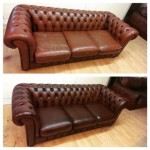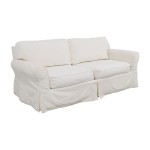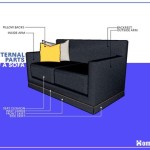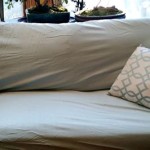Reupholstering Leather Sofa Cushions: A Comprehensive Guide
Leather sofas offer a luxurious and durable seating solution for homes and offices. Over time, however, even the highest quality leather can show signs of wear and tear, particularly on the cushions. Reupholstering leather sofa cushions can restore their appearance and extend the lifespan of the sofa, offering a cost-effective alternative to purchasing a new one. This article provides a comprehensive guide to reupholstering leather sofa cushions, covering the necessary materials, the steps involved, and considerations for achieving a professional-looking result.
The decision to reupholster leather sofa cushions often stems from a combination of aesthetic and practical concerns. Worn, cracked, or faded leather can detract from the overall appearance of the sofa and the room. Furthermore, damaged cushions may become uncomfortable and lose their structural integrity, impacting the sofa's support and comfort. Reupholstering addresses these issues by replacing the worn leather with new material, reviving the sofa's appearance and restoring its functionality.
Before embarking on a reupholstery project, it is essential to assess the condition of the cushions and the overall sofa. Consider the extent of the damage to the leather, the condition of the cushion's internal padding, and the structural integrity of the sofa frame. Minor repairs, such as cleaning and conditioning the leather, may suffice for superficial wear. However, if the leather is significantly damaged, cracked, or torn, reupholstering is the more appropriate solution. The condition of the foam or other padding material inside the cushion is also crucial. If the padding is compressed, deteriorated, or mildewed, it should be replaced along with the leather.
Successful reupholstery requires careful planning, the right tools, and a methodical approach. Rushing the process or cutting corners can result in a subpar finish and potentially damage the sofa. This guide outlines the key steps involved in reupholstering leather sofa cushions to help achieve a professional and long-lasting result.
Key Point 1: Preparing for the Reupholstery Project
Proper preparation is crucial for a successful reupholstery project. This involves gathering the necessary materials and tools, carefully removing the old leather, and creating accurate patterns for the new upholstery.
Materials and Tools: The following materials and tools are typically required for reupholstering leather sofa cushions:
- New leather upholstery: Choose a high-quality leather that is suitable for upholstery and matches the original color and grain as closely as possible. Consider factors like thickness, durability, and ease of workability.
- Upholstery thread: Select a strong thread that matches the color of the leather. Nylon or polyester thread is recommended for its strength and durability.
- Upholstery foam or batting: If the existing padding is worn or damaged, replace it with new foam or batting of appropriate density and thickness.
- Upholstery tacks or staples: These are used to secure the leather to the cushion frame or base. Choose tacks or staples that are compatible with the type of frame material.
- Tack remover or staple gun remover: Used to remove the existing tacks or staples from the old upholstery.
- Seam ripper: A small tool used to carefully remove seams from the old leather.
- Scissors or rotary cutter: For cutting the new leather to the required size and shape.
- Measuring tape: For accurate measurements of the cushion and the leather.
- Straight edge or ruler: For drawing straight lines and ensuring accurate cuts.
- Pencil or marker: For marking cutting lines on the leather.
- Sewing machine: A heavy-duty sewing machine is recommended for sewing leather.
- Upholstery hammer: For driving upholstery tacks.
- Needle-nose pliers: For gripping and pulling upholstery tacks or staples.
- Leather glue (optional): For temporarily adhering leather pieces together during the sewing process.
- Leather conditioner: For protecting and maintaining the new leather upholstery.
Removing the Old Leather: Carefully remove the existing leather from the cushion frame. Use a tack remover or staple gun remover to remove the tacks or staples that secure the leather. Be careful not to damage the frame or the cushion padding underneath. As you remove the leather, pay close attention to how it is attached and the order in which the seams are sewn. This will help you replicate the same construction when installing the new leather. Use a seam ripper to carefully remove the seams of the old leather pieces. Avoid cutting the leather itself, as these pieces will be used as templates for cutting the new leather.
Creating Patterns: Once the old leather is removed, carefully lay each piece flat and use it as a template to create a pattern for the new leather. Trace the outline of each piece onto a piece of paper or cardboard. Be sure to mark any notches, pleats, or darts on the pattern. These details are important for ensuring that the new leather fits correctly. Add seam allowances of approximately 1/2 inch to each pattern piece. This will provide enough material for sewing the seams. Label each pattern piece clearly to avoid confusion during the cutting and sewing process.
Assessing and Replacing Padding: With the leather removed, examine the condition of the cushion's internal padding. If the padding is compressed, deteriorated, or moldy, it should be replaced. Measure the dimensions of the existing padding and cut new foam or batting to the same size and shape. Select a foam density that is appropriate for the desired level of support and comfort. Higher density foams provide firmer support, while lower density foams offer a softer feel.
Key Point 2: Cutting and Sewing the New Leather
Once the patterns are created, the next step is to cut the new leather according to the patterns and sew the pieces together to form the new cushion cover.
Cutting the Leather: Lay the leather flat on a clean, smooth surface. Place the pattern pieces onto the leather, ensuring that the grain of the leather runs in the same direction on all pieces. This will help maintain a consistent appearance and prevent stretching or distortion. Trace the outline of each pattern piece onto the leather using a pencil or marker. Use a straight edge or ruler to ensure that the lines are straight and accurate. Carefully cut the leather along the marked lines using scissors or a rotary cutter. A rotary cutter can provide cleaner and more precise cuts, especially for thicker leather. Be careful not to stretch or distort the leather during the cutting process. Cut each piece with precision, following the marked lines accurately.
Sewing the Leather: Assemble the leather pieces according to the original construction of the cushion cover. Pin or clip the pieces together, aligning the edges carefully. Leather glue can be used to temporarily adhere the pieces together, making it easier to sew them accurately. Use a heavy-duty sewing machine with a leather needle to sew the seams. Adjust the stitch length and tension on the sewing machine to ensure that the stitches are strong and even. Sew each seam with a consistent seam allowance, typically 1/2 inch. Backstitch at the beginning and end of each seam to secure the stitches. Remove any pins or clips as you sew. For curved seams, ease the leather into the curve by slightly stretching or gathering the fabric as needed. After sewing each seam, trim any excess seam allowance to reduce bulk. Use a leather hammer or mallet to gently flatten the seams.
Adding Details: If the original cushion cover had any special details, such as piping, welting, or tufting, replicate these features on the new cover. Piping and welting can add a decorative touch and reinforce the seams. Tufting can create a more luxurious and comfortable feel. To add piping or welting, sew a strip of fabric or leather around the edges of the cushion cover, encasing a cord or filler material. To add tufting, mark the desired locations for the tufts on the cushion cover and sew through all layers of the fabric, securing the tufts with buttons or ties.
Key Point 3: Installing the New Upholstery
The final step is to install the new leather upholstery onto the cushion frame, ensuring a snug and secure fit. This requires careful stretching, positioning, and fastening of the leather.
Preparing the Cushion Frame: Before installing the new upholstery, inspect the cushion frame for any damage or weakness. Repair any broken or loose joints, and reinforce any areas that appear to be stressed. Ensure that the frame is clean and free of debris. If necessary, apply a sealant or finish to the frame to protect it from moisture and wear.
Stretching and Positioning the Leather: Carefully stretch and position the new leather upholstery onto the cushion frame. Start by aligning the center of the leather with the center of the frame. Gradually stretch the leather outward, working from the center towards the edges. Use your hands and fingers to smooth out any wrinkles or creases. Ensure that the leather is evenly stretched and that there is no slack or excess material. Pay particular attention to the corners and edges, where the leather may need to be stretched and shaped to fit properly.
Securing the Leather: Once the leather is properly stretched and positioned, secure it to the cushion frame using upholstery tacks or staples. Start by tacking or stapling the leather at the center of each side of the frame. Then, work your way outward, spacing the tacks or staples evenly apart. Use an upholstery hammer to drive the tacks securely into the frame. If using staples, use a staple gun to drive the staples into the frame. Be careful not to damage the leather or the frame during the tacking or stapling process. Fold over the edges of the leather and secure them to the back of the frame. This will create a clean and finished edge. Trim any excess leather from the edges of the frame.
Final Touches: After the leather is secured, inspect the cushion for any imperfections. Check for any wrinkles, creases, or loose areas. Adjust the tacks or staples as needed to ensure that the leather is smooth and evenly stretched. Apply a leather conditioner to the new upholstery to protect it from drying out and cracking. This will also help to maintain its appearance and prolong its lifespan. Clean the cushion frame with a damp cloth to remove any dirt or debris.
Reupholstering leather sofa cushions can be a rewarding project, revitalizing the appearance of furniture and extending its usability. By carefully following these steps and using quality materials, a professional-looking result can be achieved, transforming a worn sofa into a stylish and comfortable centerpiece for any room. While the process requires time and effort, the satisfaction of restoring a cherished piece of furniture makes it a worthwhile endeavor.

Tutorial Diy Upholstery Sofa Rehab A Jennuine Life

Recover Your Sofa From Leather To Fabric Stunning Transformation And A Lot Er Than New Rescot Upholstery

Leather Upholstery Furniture Sofa Chairs Couches Ottomans Replace And Recover New Restuffing Sagging Broken Down Foam

How To Reupholster Attached Couch Cushions It 39 S Been A Very Long Time Since I Ve Diy Cover

How To Restuff Sofa Cushions Plumbs Reupholstery

Leather Upholstery Furniture Sofa Chairs Couches Ottomans Replace And Recover New Restuffing Sagging Broken Down Foam

Leather Furniture Repair Couch Chair Restoration

How To Reupholster Leather Sofa With Severe Ling Of Surface Hometalk

Leather Furniture Repair Couch Chair Restoration

Leather Upholstery Furniture Sofa Chairs Couches Ottomans Replace And Recover New Restuffing Sagging Broken Down Foam
Related Posts








